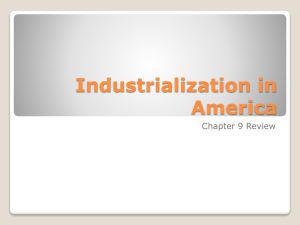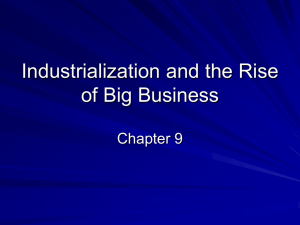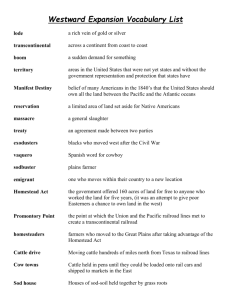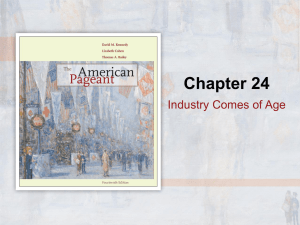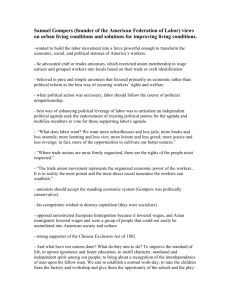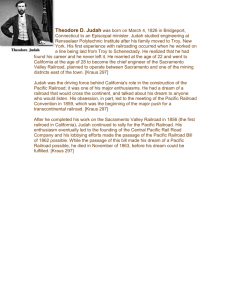Chapter 9-Industrialization (1865-1901)
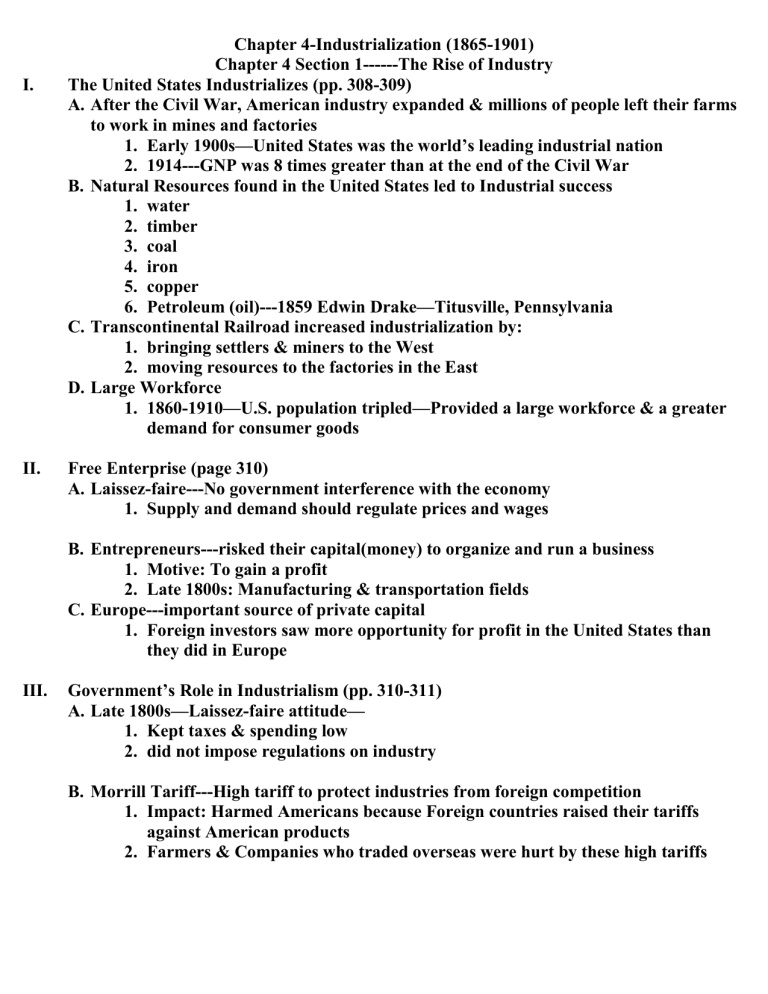
Chapter 4-Industrialization (1865-1901)
Chapter 4 Section 1------The Rise of Industry
I.
The United States Industrializes (pp. 308-309)
A.
After the Civil War, American industry expanded & millions of people left their farms to work in mines and factories
1.
Early 1900s—United States was the world’s leading industrial nation
2.
1914---GNP was 8 times greater than at the end of the Civil War
B.
Natural Resources found in the United States led to Industrial success
1.
water
2.
timber
3.
coal
4.
iron
5.
copper
6.
Petroleum (oil)---1859 Edwin Drake—Titusville, Pennsylvania
C.
Transcontinental Railroad increased industrialization by:
1.
bringing settlers & miners to the West
2.
moving resources to the factories in the East
D.
Large Workforce
1.
1860-1910—U.S. population tripled—Provided a large workforce & a greater demand for consumer goods
II.
Free Enterprise (page 310)
A.
Laissez-faire---No government interference with the economy
1.
Supply and demand should regulate prices and wages
B.
Entrepreneurs---risked their capital(money) to organize and run a business
1.
Motive: To gain a profit
2.
Late 1800s: Manufacturing & transportation fields
C.
Europe---important source of private capital
1.
Foreign investors saw more opportunity for profit in the United States than they did in Europe
III.
Government’s Role in Industrialism (pp. 310-311)
A.
Late 1800s—Laissez-faire attitude—
1.
Kept taxes & spending low
2.
did not impose regulations on industry
B.
Morrill Tariff---High tariff to protect industries from foreign competition
1.
Impact: Harmed Americans because Foreign countries raised their tariffs against American products
2.
Farmers & Companies who traded overseas were hurt by these high tariffs
C.
Early 1900s—American industries were larger & highly competitive
1.
Americans wanted free trade because they believed they could compete on an international level & succeed
IV.
New Inventions (pp. 311-312)
A.
Inventions increased American Productivity which led to wealth & job opportunities
1.
1876—Alexander Graham Bell—Telephone---(ATT)
2.
Thomas Edison—light bulb, phonograph, electric generator, motion picture
3.
Clothing Industry—Automatic loom, sewing machine, & cloth cutters
4.
Shoe industry—Mass production led to cheaper & efficiently made shoes a.
savings passed to the consumer
Chapter 9 Section 2-----------------------------------The Railroads
I.
Linking the Nation (pp. 314-416)
A.
Pacific Railway Act (1862)—provided for the construction of a transcontinental railroad by the Union Pacific & Central Pacific railroad companies
1.
1865- Union Pacific a.
weather, labor, money, & engineering problems hampered the project b.
Workers: Civil War Vets, Immigrants, farmers, miners, ex-convicts
1.
camp life was dangerous
2.
Central Pacific Railroad---Invested through the “Big Four” a.
Labor shortage---Had to hire 10,000 workers from China
II.
Railroads Spur Growth (pp. 316-317)
A.
Linked the nation & increased the size of markets
1.
stimulated the economy by spending money on steel, coal, & timber
B.
Cornelius Vanderbilt—Consolidated Railroads---New York to Chicago
C.
1883—American Railway Association---split country into 4 time zones
D.
Large integrated Railroad system benefited the nation by:
1.
providing increased efficiency
2.
making long distance travel quicker
3.
uniting Americans from different regions
III.
The Land Grant System (page 317)
A.
Land Grants were given to railroad companies by the federal government to encourage railroad construction
B.
Ex: Union Pacific & Central Pacific---sold land to settlers, real estate agents, etc
IV.
Robber Barons (pp. 317-318)
A.
Jay Gould—Worst reputation----used “Inside trading”
B.
Credit Mobilier Scandal (1872)
1.
stockholders in Union Pacific set up a construction company. (Investors signed contracts with themselves)
2.
Company greatly overcharged Union Pacific
3.
Investors made a fortune, but Railroad was almost bankrupt
4.
Congress members were given shares of stock in the Union Pacific at a low price in exchange for additional lands grants to the railroad
C.
Great Northern Railroad---James J. Hill---Most successful Transcontinental railroad
& the only one not to go bankrupt
Chapter 9 Section 3-------Big Business
I.
The Rise of Big Business (pp. 319-320)
A.
Corporation—organization owned by many people but treated by law as though it was a single person
1.
Stockholders—people who owned the corporation through purchasing stock
2.
***Issuing stock allows a corporation to raise large sums of money but spreads out the financial risks***
3.
Invest in new technologies to increase their efficiency (Economies of Scale)
B.
Advantages of Big Corporations over Small manufacturing Companies:
1.
Could produce more cheaply & more efficiently
2.
could continue to operate in poor economic times by cutting their prices to increase sales
3.
Small businesses had high operating costs (wages, supplies, shipping charges etc)
II.
The Consolidation of Industry (pp. 320-322)
A.
Competition had caused lower prices for consumers, but it also cut profits for corporations
1.
Pools—agreement to keep prices at a certain level (usually did not last because once one member cut prices the pool broke apart)
B.
Andrew Carnegie—Vertical Integration---owns all the different businesses it depends on for its operation (Saved money & made the company bigger)
C.
John Rockefeller---Horizontal Integration---combining many firms doing the same type of business into one larger corporation
D.
Monopoly---one company gains control of the entire market
E.
Trust—(1882)-Standard Oil—merged businesses without violating laws against owning other companies
1.
allows a person to manage another person’s property
F.
Holding Company—owned stock of companies that did produce goods
1.
controls all the companies it owned, merging them into one large enterprise
III.
Selling the Product (page 323)
A.
Advertising changed with illustrations replacing small-type line ads
B.
Department Stores—brought a huge assortment of products in a large, glamorous building
C.
Woolworth’s—Chain store---focuses on offering low prices instead of special services
D.
Mail Order Catalogs: Sears, Roebuck & Montgomery Ward—created to reach rural
Americans
Chapter 9 Section 4------Unions
I.
Working in the United States (pp. 326-327)
A.
Dangerous working conditions, uneven division in income between the wealthy & working class, & faced monotonous work
B.
Deflation---
1.
Caused prices to fall & increased the buying power of workers’ wages
2.
Companies cut workers’ wages
3.
Workers angry because they were being paid less for the same work
II.
Early Unions (pp. 327-328)
A.
2 Types of Industrial Workers:
1.
Craft workers---special skills & paid more
2.
Common laborers---few skills & paid less
B.
1830s—Trade Unions (Craft Workers)—Unions limited to people with specific skills
C. Industrial Unions---United all craft workers & common laborers in a particular industry
1.
Employers against Industrial Unions a.
Blacklist---list of troublemakers that made it hard for them to get a job b.
Lockout---lock workers out of the property & would not pay them c.
Hire strikebreakers (Scabs) to replace the striking union members d.
No laws that gave the workers the right to organize a union e.
Workers take an oath or sign contracts promising not to join a union f.
Unions believed to be associated with Anarchists & Marxism—People suspicious of this as immigrants came to America
III.
The Struggle to Organize (pp. 328-330)
A.
Knights of Labor (Late 1870s)—1 st Nationwide Industrial Union
1.
8 hour workday
2.
= pay for women
3.
an end to child labor
4.
worker-owned factories
5.
supported arbitration
***Haymarket affair---caused popularity of the Knights of Labor to decline*** a.
Union associated with violence & anarchism
IV.
The American Federation of Labor (pp. 330-331)
A.
American Federation of Labor—(1886)—
1.
Leader—Samuel Gompers—Unions should stay out of politics
2.
Only skilled workers could belong
3.
3 goals of the AFL: a.
to get companies to recognize unions & agree to collective bargaining b.
to push for Closed Shops—Companies only hire union members c.
promote an 8 hour workday
V.
Working Women (page 331)
A.
1900—Women made up > 18% of the workforce
B.
Women were paid less than men—Men had to support a family
C.
Most union excluded women
D.
Women’s Trade Union League (WTUL)—1 st national association dedicated to promoting women’s labor issues


